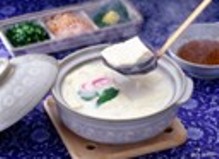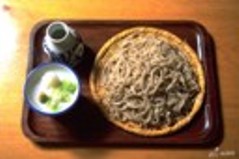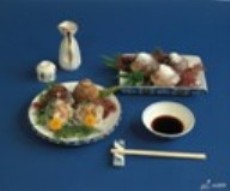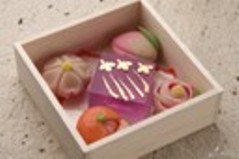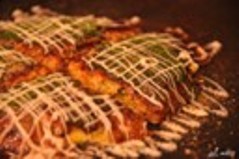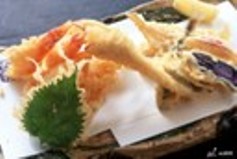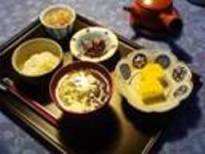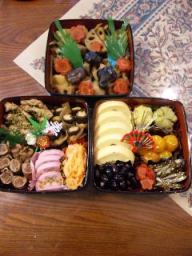Food
Image by: © Olivia Braddock
Japanese food generally is regarded as healthy due to its low fat content.
Traditional Japanese food is based on rice, fish and Miso soup (soya bean paste).
Beans 豆(まめ)
Did you know that the Japanese eat more soy beans (daizu) that any other nation in the world? Why? Well in the past, Buddhists were not allowed to eat four-legged animals. So, to get the protein, soya beans were consumed.
(Photo by: © Mrs. Hisaka Bunting)
Bean products; Tofu 豆腐, soy sauce and Miso 味噌
Tofu is a bean curd produced from soy beans which are also used to manufacture soy sauce (shoyu) and miso paste, made from fermented soy beans and rice and used for flavouring and making soup. Most meals are eaten with rice and miso soup.
(Photo by: © JNTO)
Noodles
The main types of noodles eaten in Japan are Soba, Ramen and Udon
Soba そば are noodles made of buckwheat and are dark brown in colour. We eat them hot in soup in winter and cold with dipping sauces in summer.
(Photo by: © JNTO)
Ramen ラーメン originally comes from China and is usually served in soup with toppings such as sliced pork, bamboo shoots and boiled egg. Three main soup bases are soy sauce, salt and miso.
Udon うどん are thick, white noodles. As with soba they are eaten hot in soup in winter and cold with dipping sources in summer.Fish Japan is surrounded by two sea currents which give a rich variety of fish according to the season. Seaweed and raw fish (sushi) are commonly eaten. The famous sushi is made up of vinegared rice with raw fish on top.
(Photo by: © JNTO)
Because in the past, people could not generally travel freely, different regions developed their own dishes, dependent on the local climate. These local delicacies still exist today, such as the clam dish in the photo, from Miyazaki.
Sweets
Japanese sweets (Wagashi) are made to express different seasons.
(Photo by: © JNTO)
Pancakes Okonomi-yaki お好み焼き(おこのみやき)
Okonomi-yaki comes from Osaka. It is a kind of pancake made with a flour batter and filled with cabbage and a variety of fillings such as pork, shrimp and vegetables. It is fried on a metal plate and topped with brown sauce, mayonnaise and fish flakes. It is one of many regional dishes.
(Photo by: © JNTO)
Tempura 天ぷら(てんぷら)
Tempura is a Japanese form of deep-fried fish and vegetables in a light batter which is said to have come from Portuguese traders in the sixteenth century. The most common ingredients are king prawns, shiitake mushrooms, bell peppers and aubergine etc.
(Photo by: © JNTO)
Sukiyaki すき焼き(すきやき)
Until about 150 years ago when the Meiji Revolution took place and the country was open to the rest of the world, Japanese people were not allowed to eat four legged animals because of the Buddhist belief that you should not kill living animals. Sukiyaki is a dish from Meiji period where slices of beef are cooked in a steel pot along with vegetables. The dish became very popular and it remains popular today.
(Photo by: © JNTO)
Before eating, say Itadakimasu (いただきます) which literally means “I/we are going to have”. When you’ve finished, say Gochisousama deshita (ごちそうさまでした)which means “thank you for a delicious meal”.
When you like the food, you can say: Oishii desu. (おいしいです。”It’s delicious.”) However, don’t worry if you do not like it, you can say: (name of food) wa chotto…(xxは、ちょっと。),a polite way of saying you do not like something.
At home, normally each person has their own chopsticks as well as their own rice bowl. Soup is served along with a main dish and other smaller dishes.Breakfast 朝ごはん(あさごはん) Traditional Japanese breakfast consists of a bowl of rice, a bowl of miso soup, grilled fish, nattou, an egg dish of some sort and pickles. Japanese rice is sticky so it is not too difficult to pick up with a pair of chopsticks, but you can hold the rice bowl to make it easier to eat from. In miso soup, you may find bean curd, fried bean curd, radish called daikon (Mooli), carrots or spinach, depending on what is available.
(Photo by: © Mrs Hatsune Kajikawa)
Western style breakfast is also taken. Egg and bacon etc and salad with a thick slice of toast. A quick fix of coffee and a bread roll is popular for office workers for breakfast before they start work.
Eating out is very popular in Japan. Each restaurant serves specialised dishes. For example, if you want to have Sushi, you go to a Sushiya (ya means “house”.) If you want Tempura then go to a Tempuraya or a Sobaya for Soba or Udon noodles.
A family restaurant (or famiresu for short) caters for any taste, eg pasta, curries, hamburgers, noodles. and prices in order to help you decide what to eat.
Reasonably priced restaurants display food models
(Photo by: © Mrs. Hisaka Bunting)
Dinner at Japanese Inns (Ryokan)
A stay at a Japanese Inn or Ryokan usually includes an evening meal, served in your room with a personal maid.
It consists of many different dishes, which vary according the season and region. The photo shows a dinner for two people.(Photo by: © JNTO)
Osechi ryouriis the name given to the special meal eaten at New Year's Time (shōgatsu). It signifies new beginnings. It consists of a beautiful box with small portions of many different dishes, each of which has a special meaning relating to the New Year. For example, herring eggs signify plentiful offspring in the coming year. Boxes are stackable with three or five layers. The food lasts for three days as it is preserved well and also because odd numbers are significant in Japan
(Photo by: © Mr. Shigemi Matsunaga)

